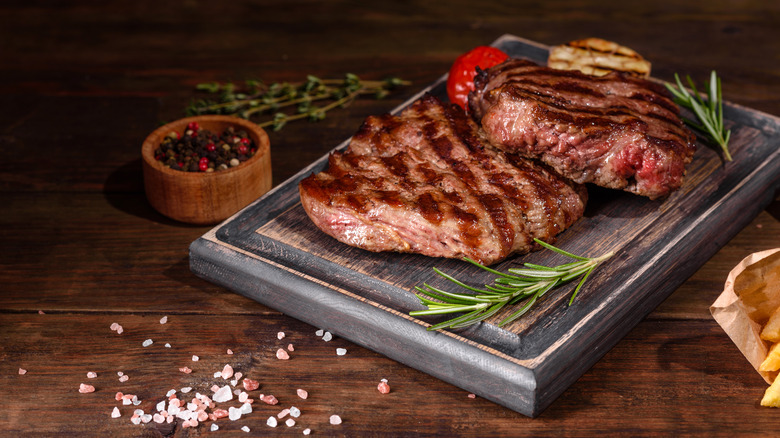Andrew Zimmern's Tip For Tender Steaks Lies In What He Doesn't Do
If you're someone who loves a perfectly-cooked steak, chances are you've educated yourself about all the tips and tricks for grilling up a slab of beefy perfection. You want to start off by picking a cut that delivers on what you want, paying attention to the thickness as well as the level of fat in your steak. You also need to allow that steak to come to room temperature before you even think about cooking it — if your steak is cold when it hits the super-hot grill or pan, you run the risk of those muscle fibers tensing up and consequently creating a tougher mouthful.
However, Andrew Zimmern has one particular tip that will help ensure your steak is as tender as possible — and it requires absolutely zero extra effort or ingredients. All you need to follow his lead is some extra time. Patience is the key to mouthwatering steak..
While you likely enjoy most dishes piping hot, that perhaps shouldn't be an expectation you have from steak. That is, not if you want to enjoy steak at its peak tenderness. As Zimmern revealed to Insider, he prefers to consume his steaks at room temperature or even once they've cooled. That's because when the temperature of the steak drops a bit as it's resting (a crucial step we'll get into), "all of that fat goes back into the muscles and it becomes much more tender," according to Zimmern.
The 411 on resting your steak
So, Andrew Zimmern swears by allowing his steak to rest long enough that all that heat from the grill dissipates, resulting in a room temperature or even cool piece of meat to enjoy (don't worry, you can still serve it up with your favorite piping-hot sides). But, why is it so critical to give your steak time to rest rather than just bringing it from the grill to your plate immediately? It's all about the juices, something you should definitely care about if you're aiming for a perfectly tender steak.
If you've ever cut into a steak while it's still hot and noticed the juices flowing out, don't pat yourself on the back for a job well done — that reaction isn't because you've cooked an overwhelmingly juicy steak, it's because you're allowing all the juices within the steak to escape. However, if you give your steak ample time to rest, those juices that are bunched near the center of your steak will slowly begin to redistribute throughout all the muscle fibers, ensuring every single bite is moist and tender.
While everyone's preference is different — and Zimmern may favor a slightly longer rest time, given his penchant for cooler steaks — a good rule of thumb is to base the rest time on the size of the steak, resting your steak for a minimum of one minute per 3 to 3.5 ounces of meat.

